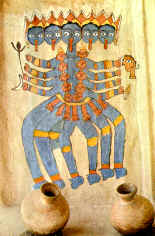|
|
India's artistic traditions are ancient, esoteric and deeply rooted in religion. While in various times in her long history, foreign races and cultures exercised some influence on Indian art forms, the main aesthetic current has remained predominantly Indian and has preserved classical traditions of music, dance, literature, architecture, sculpture and theatre.
Hundreds of temples with intricate carvings, unique murals of Ajanta and the bronze of South India were all largely inspired by the instinct of worship. Handicrafts of India today still retain much of the spirit of age-old tradition.
With coming of Muslims in 12th century AD, traditional Hindu are felt the overpowering impact of a new religion and culture. As new rulers settled and built palaces and mosques, tombs and gardens, employing local artisans and craftsmen, Saracenic style blended with Hindu.
Mongol, among the world's great builders, carried this synthesis to a level of perfection, of which Taj Mahal is the most famous example. In the realm of painting, some of the miniature masterpieces of Mongol and the later, Rajput and Pahari schools could be seen in India's museums.
Modern art in India bears the impact of the classical and folk idioms indigenous to India, as well as of recent trends in world art. Since independence, Indian artists have shown great vigor and an urge for experimentation.

|
|

